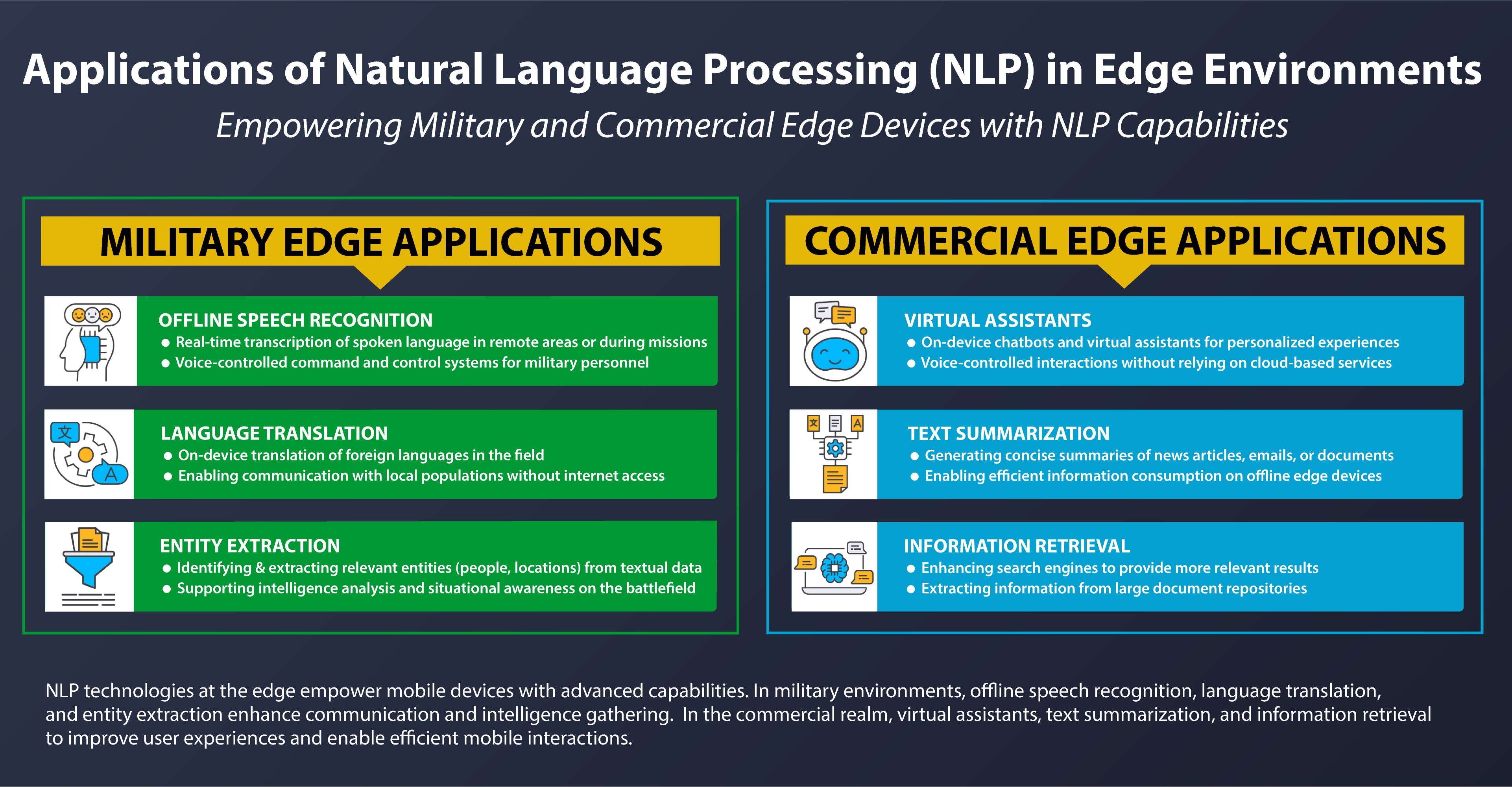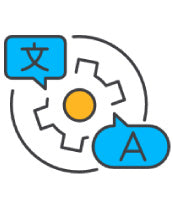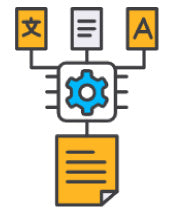
By Jim Ison, Chief Product Officer
In today's fast-paced world, where technology continues to shape our daily lives, Natural Language Processing (NLP) has emerged as a transformative force. NLP is a branch of artificial intelligence (AI) that focuses on the interaction between computers and human language. It enables machines to understand, interpret, and generate human language, opening up a world of possibilities for rugged edge environments such as aircraft, helicopters, maintenance hangars, and autonomous truck depots.
In this blog post, we will explore the fundamentals of Natural Language Processing and its applications in rugged edge environments. We will delve into how NLP empowers military and commercial operations, enhancing communication, intelligence gathering, decision-making, and user experiences in challenging, resource-constrained environments.

View larger as a pdf View text version
Understanding Natural Language Processing
At its core, Natural Language Processing (NLP) combines linguistics, computer science, and AI to bridge the gap between human language and machine understanding. NLP algorithms enable computers to comprehend and derive meaning from human language, whether it is written or spoken. The goal of NLP is to enable machines to process, interpret, and generate natural language in a manner that is similar to human communication.
Key Applications of NLP in Rugged Edge Environments:
 |
Offline Speech Recognition In rugged edge environments, such as military aircraft or remote locations, internet connectivity may be limited or unreliable. Offline speech recognition, a critical application of NLP, allows edge devices to transcribe and understand spoken language in real-time without the need for external infrastructure or network dependencies. This capability enables seamless communication among military personnel during missions or maintenance activities, enhancing efficiency, safety, and situational awareness. |
|
 |
Language Translation Operating in foreign territories or interacting with local populations can present significant language barriers. In the military, these interactions are done by troops on the ground or in the air in hostile and sometimes harsh environments. NLP-driven language translation empowers edge devices that operate in these harsh environments, such as in the troops’ backpack, inside ground vehicles and in helicopters, to perform real-time translations, enabling effective communication without relying on internet connectivity. Whether it's for military personnel conducting missions, or commercial operators managing logistics, on-device language translation bridges language gaps, fosters understanding, and facilitates successful operations. In the medical field, this could take the form of facilitating accurate communications between patients and medical professionals that speak different native languages where symptoms and procedures cannot be ambiguous. |
|
 |
Entity Extraction Extracting and analyzing relevant entities, such as people, locations, or organizations, from a mountain of textual data is crucial in edge applications. NLP algorithms deployed on edge devices can identify and extract these entities from unstructured text, supporting intelligence analysis, real time decision-making, and situational awareness. Military personnel can leverage entity extraction to gain insights from large volumes of data, such as making sense of the chaos of a battlefield, thereby enhancing operational effectiveness. In commercial applications, such as maintenance hangars or autonomous truck depots, entity extraction can assist in managing maintenance manuals, route documentation, cargo inventory routing, or putting the right maintenance personnel with the right expertise on a repair or project. |
|
 |
Virtual Assistants Rugged edge applications benefit immensely from on-device virtual assistants powered by NLP. These virtual assistants, often in the form of chatbots or voice-controlled interfaces, provide personalized experiences and real-time interactions without relying on connections to cloud-based services. In military operations, virtual assistants assist soldiers with tasks, provide critical information quickly, and support decision-making, enhancing efficiency and effectiveness. In the commercial realm, maintenance personnel can rely on virtual assistants for technical guidance, troubleshooting support, or equipment documentation, while logistics operators can optimize schedules, obtain route information, and receive real-time updates through voice-controlled interactions. NLP can be combined with other applications, such as digital twin, to become even more effective in remote locations. |
|
 |
Text Summarization Efficient information consumption is paramount in rugged edge environments, where time and resources are often limited. NLP-based text summarization algorithms allow edge devices to generate concise summaries of news articles, emails, or documents, providing the key points without overwhelming the user. This capability empowers military personnel to quickly digest intelligence reports, operation orders, or mission briefings, enabling informed decision-making. In the commercial sector, text summarization assists maintenance technicians in accessing critical information, helps logistics operators stay updated on industry news, and supports efficient communication within the supply chain. Think of this as an AI generated executive summary, when large volumes of data would overwhelm the user. |
|
 |
Information Retrieval Quick and accurate information retrieval could be crucial in edge locations that lack cloud connectivity or that cannot wait to support decision-making and operational efficiency. NLP algorithms deployed directly on edge devices enhance search capabilities, allowing for the extraction of relevant information from large document repositories, without relying on external servers or cloud-based services. This empowers military personnel and commercial operators to access technical manuals, operational procedures, or inventory data on the go, facilitating smooth operations, reducing downtime, and enabling efficient decision-making. Let’s examine, for example, a damaged aircraft is on approach to a remote airfield and the airfield has both a repair manual consisting of thousands of pages of instructions and a virtual “digital twin” AI model of the aircraft that can be examined on a ground station computer. Telemetry of the aircraft communicated to the ground station can show maintenance personnel the extent and location of the damage on the digital twin of the aircraft. It can have the virtual assistant sort through the manual using NLP to retrieve the relevant information for the maintenance team, so they have the exact repairs and parts needed to be prepared to repair the aircraft before it even lands at the airfield. |
Conclusion
Natural Language Processing (NLP) has revolutionized communication, decision-making, data availability, and user experiences in rugged edge environments. By enabling machines to understand and generate human language, NLP empowers military and commercial operations in aircraft, helicopters, maintenance hangars, and autonomous truck depots. Offline speech recognition, language translation, entity extraction, virtual assistants, text summarization, and information retrieval are just a few of the applications that enhance efficiency, safety, and situational awareness in resource-constrained environments.
As technology continues to advance, the potential of NLP in rugged edge environments will only grow. By leveraging the power of language understanding and communication, organizations can unlock new possibilities, ensuring seamless operations and transforming the way we interact with technology in even the most challenging conditions.
This blog was assisted by the Natural Language Processing provided by ChatGPT. It uses all the examples of NLP in the blog to gather, translate, sort, and summarize the millions of words, transcripts, articles, and documents from the internet to create an end product in easy-to-understand natural language tailored to the needs of the user. Along with the real-world examples from my human experience providing NLP systems to government and commercial edge applications, the end blog product becomes a useful tool in providing understanding to a broad modern AI topic.
Click the buttons below to share this blog post!
MILITARY EDGE APPLICATIONS:
OFFLINE SPEECH RECOGNITION:
LANGUAGE TRANSLATION:
ENTITY EXTRACTION:
COMMERCIAL EDGE APPLICATIONS:
VIRTUAL ASSISTANTS:
TEXT SUMMARIZATION:
INFORMATION RETRIEVAL:
NLP technologies at the edge empower mobile devices with advanced capabilities. In military environments, offline speech recognition, language translation, and entity extraction enhance communication and intelligence gathering. In the commercial realm, virtual assistants, text summarization, and information retrieval, to improve user experiences and enable efficient mobile interactions.

By: Jaan Mannik – Director of Commercial Sales
The term AI, or Artificial Intelligence, is everywhere nowadays and has quietly woven itself into the fabric of our daily lives. It powers the recommendations we see on streaming platforms, the navigation apps that guide us through traffic, and even the virtual assistants that answer our questions in seconds. From optimizing energy use in smart homes to predicting market shifts in finance, AI has become the invisible engine driving convenience, efficiency, and insight across industries.
In manufacturing, AI-driven robots collaborate with humans to streamline production. In agriculture, machine learning models monitor crops, forecast yields, and conserve resources. Retailers use predictive analytics to anticipate consumer needs before customers even express them. The reach of AI is no longer confined to futuristic labs, it’s in our phones, vehicles, and cities, constantly learning and adapting to serve us better.

OSS PCIe-based products deliver critical advantages for modern military sensor systems by enabling real-time data acquisition, processing, and transmission in rugged, mission-critical environments. These benefits stem from their ability to support high-bandwidth, low-latency interconnects, modular scalability, and environmental resilience, all of which are essential for today’s advanced military platforms.

Companies today are being asked to do more with data than ever before. Bigger AI models, faster insights, and workloads that don’t stay in one place, it’s a lot to keep up with. Traditional infrastructure just isn’t built for this kind of speed and flexibility.
The answer isn’t about throwing more hardware at the problem. It’s about building smarter, more agile infrastructure that adapts as demands change. And that’s where scale-out and increasingly, a blend of scale-out and scale-up come into play.